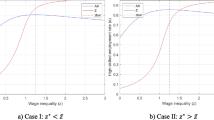Abstract.
This paper constructs a general equilibrium model of equilibrium unemployment by combining an endogenous growth model with a variant of equilibrium search theory. The analysis offers two explanations for the causes of widening wage gap between skilled and less-skilled labor, and rising unemployment rate among the less skilled: technological change in the form of an increase in the size of innovations or skilled labor saving technological change in R&D activity.
In addition, the model identifies two distinct effects of faster technological progress on the aggregate unemployment rate. First, it increases the rate of labor turnover and therefore increases the aggregate unemployment rate – the creative destruction effect. Second, it creates R&D jobs, which offer workers complete job security, and consequently reduces the aggregate unemployment rate – the resource reallocation effect.
Similar content being viewed by others
Author information
Authors and Affiliations
Additional information
Rights and permissions
About this article
Cite this article
Şener, M. A Schumpeterian model of equilibrium unemployment and labor turnover. J Evol Econ 10, 557–583 (2000). https://doi.org/10.1007/s001910000052
Issue Date:
DOI: https://doi.org/10.1007/s001910000052




